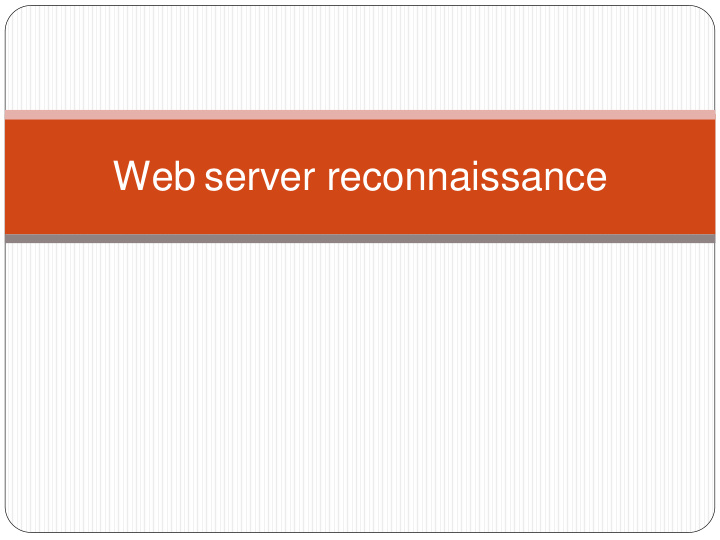



Web server reconnaissance
Reconnaissance and fingerprinting Finding information about a target web server/web site May be illegal to perform reconnaissance on a web server and web site without prior approval/permission. Simulate via war games to demonstrate issues with trusting clients with URLs and filenames Fingerprinting information Name and version of server Database backend Use of reverse proxy (nginx) Programming language and web application server
1. Viewing HTTP headers $ nc – C vulnerable 80 GET / HTTP/1.1 Host: vulnerable HTTP/1.1 200 OK Date: Sun, 03 Mar 2013 10:56:20 GMT Server: Apache/2.2.16 (Debian) X-Powered-By: PHP/5.3.3-7+squeeze14 Content-Length: 6988 Content-Type: text/html $ nc – C oregonctf.org 80 $ nc – C cs410.oregonctf.org 80 HEAD / HTTP/1.1 HEAD / HTTP/1.1 Host: foobar Host: cs410.oregonctf.org
2. Viewing source content Look for comments, links, or directory structure Wikipedia (en.wikipedia.org) Mercedes-Benz (www.mercedes-benz.com/en)
2. Viewing source content Hyatt.com GitHub Hint: Asset cache busting pipeline Blackboard
2. Viewing source content External services https://builtwith.com https://wappalyzer.com https://urlscan.io
3. Search engine signals Google, Yahoo, Bing, will crawl everything on your site unless you tell them otherwise. Prevent via use of robots.txt file Instructs search engine spiders how to interact with your content. Can also reveal sensitive information
3. Search engine signals For hacker, robots.txt can contain interesting folders, files, and data to investigate. Sometimes even passwords, usernames, ... Example Specifies that no robots should visit any URL starting with "/cyberworld/map/" or "/tmp/", or /foo.html.
# If the Joomla site is installed within a folder such as at # e.g. www.example.com/joomla/ the robots.txt file MUST be # moved to the site root at e.g. www.example.com/robots.txt # AND the joomla folder name MUST be prefixed to the disallowed # path, e.g. the Disallow rule for the /administrator/ folder # MUST be changed to read Disallow: /joomla/administrator/ # # For more information about the robots.txt standard, see: # http://www.robotstxt.org/orig.html # # For syntax checking, see: # http://tool.motoricerca.info/robots-checker.phtml User-agent: * Disallow: /administrator/ Disallow: /cache/ Disallow: /cli/ Disallow: /components/ Disallow: /images/ Disallow: /includes/ Disallow: /installation/ Disallow: /language/ Disallow: /libraries/ Disallow: /logs/ Disallow: /media/ Disallow: /modules/ Disallow: /plugins/ Disallow: /templates/ Disallow: /tmp/
4. Artifacts favicon.ico Default icons indicate software package being used Which package? Search-engine worms (Santy worm 2004) phpBB
4. Artifacts Application-specific 404 error pages Tomcat, Ruby on Rails Rub on Rails
4. Artifacts Stack trace of web application Inject %00, %22, %27 to check for injection vulnerabilities
5. TLS transparency reports Rogue certificate authority can create valid certificates for sites it is not supposed to Force all authorities to log every certificate (for HTTPS) issued to a central location Browsers eventually will reject those that are not logged But, exposes all of the names of machines an organization has generated certificates for Potential targets for adversaries https://transparencyreport.google.com/https/certificates https://observatory.mozilla.org/ (TLS section) Demo: Lookup all oregonctf.org certificates and who issued them
6. Fuzzing Brute-force common directory names (e.g. admin, config, conf, src) Brute-force admin pages with default admin credentials wfuzz tool Detect directories and pages on the web server using wordlists of common resource names. $ wfuzz -c -z file,wordlist/general/common.txt --hc 404 http://vulnerable/FUZZ nmap tool General tool supporting any number of scans Can specifically be used to enumerate directories in web servers similar to wfuzz nmap --script http-enum w.x.y.z
Lab: A0 Reconaissance See handout
Recommend
More recommend